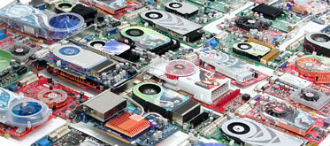 Financial analysts on Wall Street yesterday gave credence to rumours that Advanced Micro Devices (AMD) is up for sale.
Financial analysts on Wall Street yesterday gave credence to rumours that Advanced Micro Devices (AMD) is up for sale.
 Financial analysts on Wall Street yesterday gave credence to rumours that Advanced Micro Devices (AMD) is up for sale.
Financial analysts on Wall Street yesterday gave credence to rumours that Advanced Micro Devices (AMD) is up for sale.
 A group of scientists at the Vienna University of Technology, claim their invention will lead to the next generation of outdoor displays.
A group of scientists at the Vienna University of Technology, claim their invention will lead to the next generation of outdoor displays.
 In a bid to generate more revenues, graphics firm Nvidia is to start licensing its GPU designs to other companies.
In a bid to generate more revenues, graphics firm Nvidia is to start licensing its GPU designs to other companies. Graphics chip maker Nvidia posted higher fiscal third quarter revenue than many of the cocaine nose jobs of Wall Street expected.
Graphics chip maker Nvidia posted higher fiscal third quarter revenue than many of the cocaine nose jobs of Wall Street expected.
Revenue in the fiscal third-quarter ended Oct. 26 was $1.225 billion, up 16 percent from the year-ago quarter, compared with Wall Street’s random guess of $1.202 billion.
For the current fourth quarter, Nvidia said it expects revenue of $1.20 billion, plus or minus two percent. Analysts on average expected fourth quarter revenue of $1.198 billion.
Third-quarter net profit was $173 million compared to $119 million a year ago.
Nvidia did better by focusing on using its Tegra chips to in entertainment and advanced navigation systems in cars made by companies including Volkswagen’s Audi, BMW and Tesla.
In the third quarter, revenue from Tegra chips for automobiles and mobile devices jumped 51 percent to $168 million. Nvidia’s PC graphics chip business expanded 13 percent to $991 million.
 Nvidia is ahead of AMD on the graphics front and it won’t be until next year that the Sunnyvale firm catches up.
Nvidia is ahead of AMD on the graphics front and it won’t be until next year that the Sunnyvale firm catches up.
That’s according to financial analyst Sean Chandler, who works for Seeking Alpha.
He said in a note to his clients that the Nvidia “Maxwell” architecture has put AMD under heavy pressure in the consumer graphics arena. And that’s worry investors and taking its toll on the AMD share price.
Chandler said that while AMD’s restructuring are widely seen as positive, the firm “still needs to release competitive technologies to remain relevant”.
Nvidia Maxwell, he said, means “monumental advancements” in both efficiency and performance.
Nvidia’s 60watt 750Ti is comparable to AMD’s 150 watt R7 260X, he said. And Maxwell also outforms AMD in performance efficiency per die size.
He added that the rumour mill suggests AMD may respond with 20 nanometre chips now chip foundry TSMC has got the shrink down pat.
He suggests to investors: “AMD is almost certainly not out of the game, but be cautious and don’t pour all of your eggs into one basket.”
 GPU shipments are recovering and according to Jon Peddie Research, the graphics market increased 4.6 percent last quarter, while the PC market as a whole took a 2.5 percent sequential dip. Intel and AMD upped their market share, at Nvidia’s expense, of course.
GPU shipments are recovering and according to Jon Peddie Research, the graphics market increased 4.6 percent last quarter, while the PC market as a whole took a 2.5 percent sequential dip. Intel and AMD upped their market share, at Nvidia’s expense, of course.
The increase in overall GPU shipments reveals that many customers are choosing to “double-attach,” or add a discrete GPU to a system with integrated graphics. This doesn’t really paint the full picture, as practically all Intel non-server chips ship with integrated graphics and the same goes for more than two thirds of AMD chips. As a result, the average PC today has 1.4 GPUs on board.
On a year-to-year basis total graphics shipments in the second quarter dropped 6.8 percent. Once again this was better than PC shipments, which slipped 11.2 percent. JPR expects the total shipments of graphics chips in 2016 to hit 319 million units and the CAGR from 2012 to 2016 now stands at -1.4 percent.
AMD’s overall PC graphics shipments increased 10.9 percent and the company upped its market share to 21.9 percent. However, shipments of APUs declined 9.6 percent. Shipments of APUs in notebooks increased 47.1 percent, but it should be noted that AMD’s presence in notebooks is rather limited. With that in mind all it takes to get such a high figure is a few design wins.
Intel’s desktop graphics shipments dropped 1.4 percent, but notebooks were up 12.1 percent. Intel’s overall shipments increased 6.2 percent.
Nvidia was the big loser last quarter. Its desktop discrete shipments were down 8.9 percent, while discrete mobile shipments were down 7.1 percent. It should be noted that Nvidia scored the vast majority of Haswell notebook design wins, but new notebooks aren’t exactly flying off shop shelves right now.
Although some of the numbers are encouraging, total GPU shipments were down 5.2 percent from the same quarter last year. The trend for discrete GPUs remains negative, with a CAGR to 2016 of -2.2 percent.
 AMD’s next generation graphics card, the Radeon HD 9970, is about to hit the channel.
AMD’s next generation graphics card, the Radeon HD 9970, is about to hit the channel.
According to WCCtech, AMD’s Volcanic Islands GPU uses a new architecture making use of process enhancements and increased amount of stream processors.
It is supposed to be a lot better than the HD 7000 series but AMD has managed to keep the technical or specification details fairly quiet.
Even the name isn’t official yet, but the rumour is that AMD was going to skip the HD 8000 series branding and just go with the HD 9000 name.
The reason for this is because the AMD FX processors are also branded as FX-9000 series.
While the techies think that the cards will be a Titan killer there is some interest as to whether the graphic card will perform better than the GK110 core from NVIDIA.
The AMD Radeon HD 9970 and the rest of the HD 9000 series SKUs are reportedly launching in October 2013 or Q4 2013. This would put the HD 9000 series cards against the GeForce 700 series cards.
NVIDIA has high hopes that its Kepler GK110 and GK104 based cards are good enough to compete against the new AMD cards and it is not releasing any new card till Q4 2013.
 AMD has launched its Radeon HD 8970, boasting it’s currently the fastest notebook graphics card in the world.
AMD has launched its Radeon HD 8970, boasting it’s currently the fastest notebook graphics card in the world.
The GPU is powered by AMD’s Graphics Core Next architecture and sports the company’s Enduro technology to keep battery life running smoothly, adjusting the requirements of the GPU in idle mode.
The 8970M is essentially a rebranded 7970M with a 500MHz GPU boost clock.
Nonetheless, AMD boasted about it coming with AMD Eyefinity for use on multiple monitors, and it has AMD App Acceleration which lets the GPU take workload pressure off the CPU, and the card supports DirectX 11.1 on Windows 8.
MSI’s VP for sales and marketing, Eric Kuo, said in a statement that the HD 8970M card was a perfect fit for the company’s new gaming laptop, the MSI GX70. “Its speed, features and intelligent power capabilities perfectly complement our product,” Kuo said.
Matt Skyner, corporate veep for Graphics Business Unit at AMD, promised that the card is fast, powerful and energy efficient, making it a great candidate for gamers who need top performance and long-lasting battery life.